Thuja western "Smaragd": description, varieties and cultivation
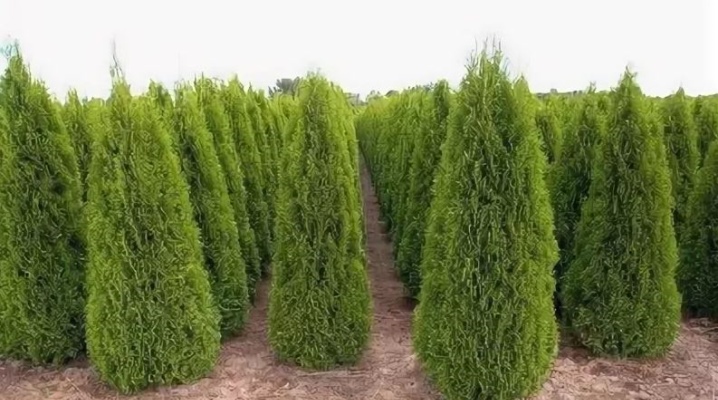
Many landscape designers recommend to turn their attention to the western “Smaragd”, which, although it is quite high, still looks very compact and does not clutter up the territory. In addition, this tree has a number of other features, but in order for it to grow healthy and strong, it must be taken care of. Let us consider in more detail the description and varieties of this variety, as well as the features of growing a healthy tree and the rules for its reproduction.
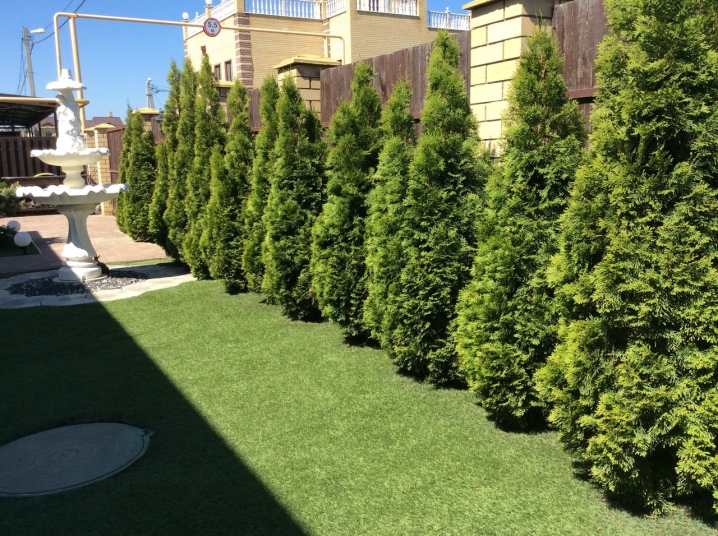
Description
Thuja western "Smaragd" is a very beautiful tree with a luxurious fluffy crown and very compact size, in comparison with many other trees. For example, the maximum height of an adult tree can reach 6 meters, while the crown, in the absence of regular cutting and processing, spreads to a diameter of up to 2 meters. This thuja is considered a long-liver, since its average life expectancy is about 130 years. At the same time, the growth rate of the tree is rather slow, since annually thuja adds 15-20 cm in height, and only 5 in width. The tree grows rapidly only in the period after planting, when young shoots form a crown, and the root system tends to strengthen in fresh soil.
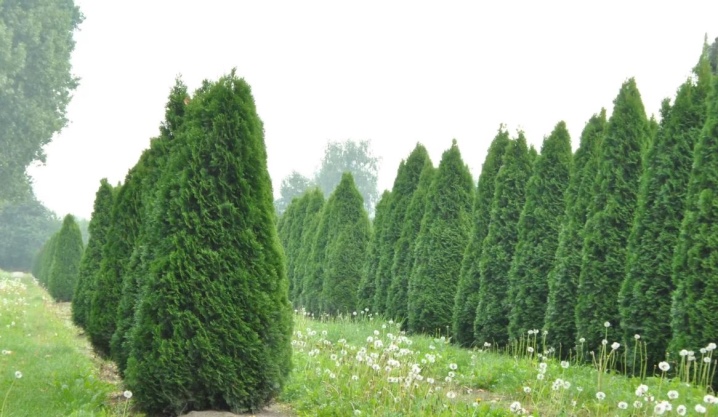
As for the rest of the characteristics, the following can be noted.
- The natural shape of the tree is a cone, but thanks to the art of landscaping, it can be given any look.
- Thuja "Smaragd" is an evergreen plant.
- During the flowering period, small oblong brown cones can be seen on the tree.
- Thuja occidentalis secretes a special substance - phytoncid, which helps to purify the air. That is why thuja are planted not only in summer cottages, but also in urban areas.
- It is this type of plant that can have two color options: green and golden.
- This plant perfectly tolerates winters and polluted environmental conditions.
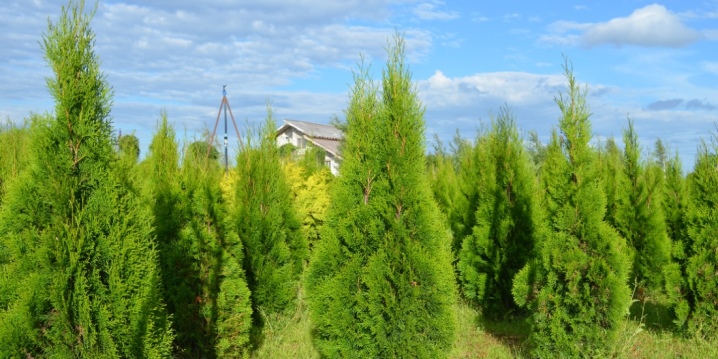
Varieties of varieties
There are several varieties of this variety of thuja, each of which has its own unique characteristics.
- For example, for the variety "Smaragd Variegata" characterized by a bright green crown, the color of which persists throughout life, decorated with unusual shoots, the ends of which are white. Due to this, this variety is very often used as a decorative element in landscape design.
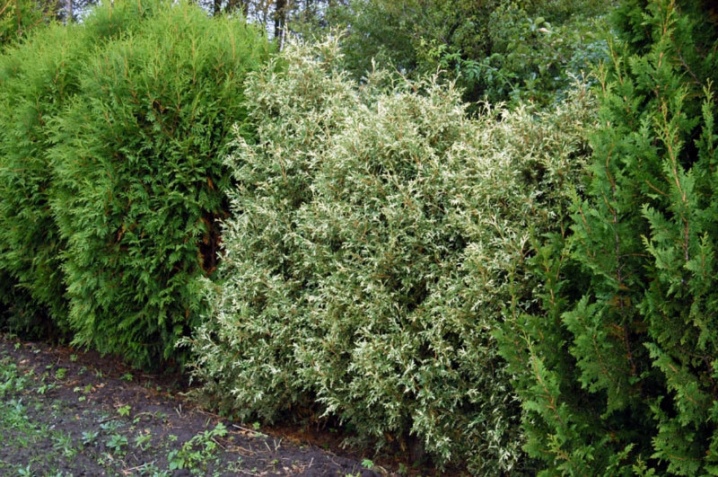
- "Sunny Smaragd" is a relatively new variety of western thuja, which is characterized by very fast growth, as well as a pronounced pointed cone shape. The branches of a young tree have an orange tint, and the crown is light green, but with age, the color of the branches turns brown, and the needles acquire an emerald tone.
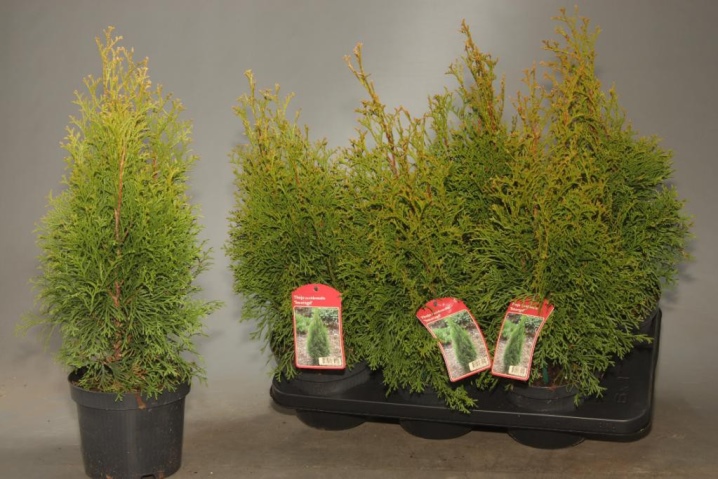
- Variety "Spotty Smaragd" has a rather loose crown, but despite this, the tree looks quite voluminous and fluffy. This effect is achieved due to the fact that this variety is not characterized by the usual conical shape, but wider at the bottom - pyramidal.
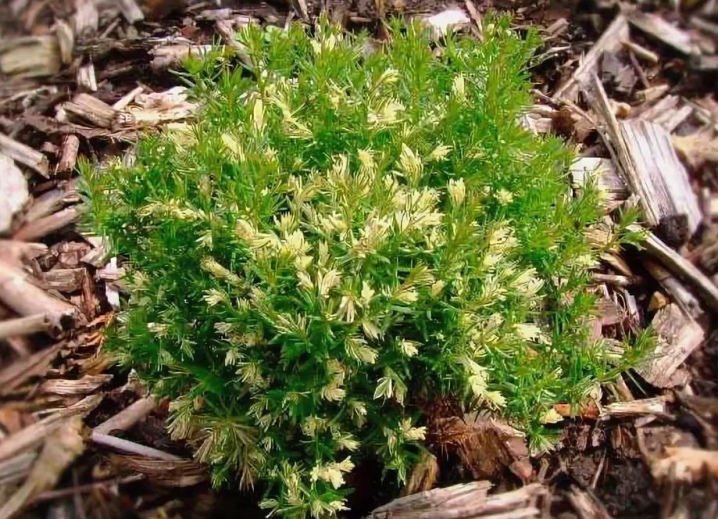
- Thuja "White Smaragd" is the most capricious in relation to the conditions of its growth. It is very sensitive to polluted environmental conditions, so the growth of the tree slows down to a minimum.But when placed in a sunny spot with well-drained soil, your tree will look amazing.
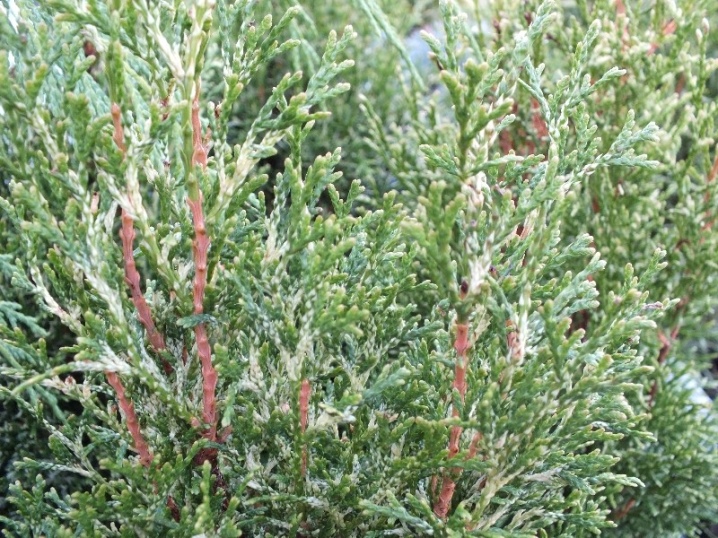
- Thuja western "Silver Smaragd" has a characteristic feature in the form of a loose crown shape, as well as lighter ends of the shoots. This variety is slow-growing, so it is perfect for planting in small areas.
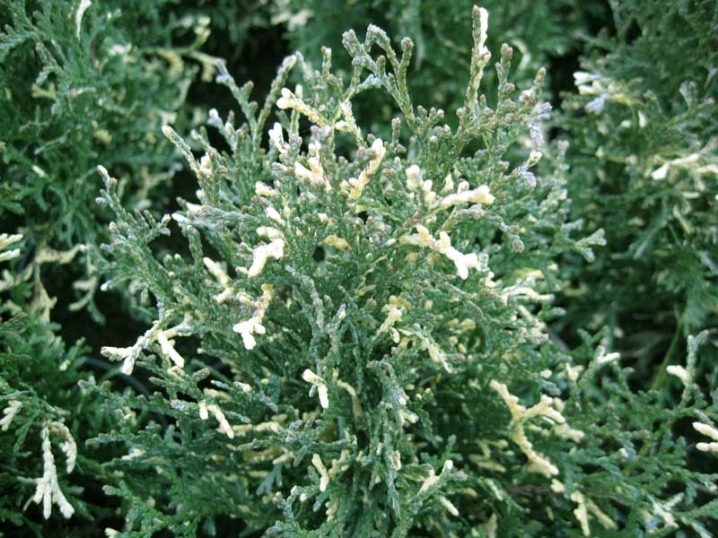
The best time to plant
In order for the tree to take root, it is necessary to determine the correct time to plant it. This is very important, because at certain time intervals and under certain climatic conditions, the plant may simply die. For example, in case of sudden frost or too bright sun in an open space. It is believed that the most suitable period for planting this plant in open ground is early spring, the period until the sap flow began, but the soil has already warmed up to an optimal state. Approximate planting dates are determined in March-April, but it is still necessary to take into account both the climate and weather conditions in the region where you live. That is, in southern cities, planting a tree can be done much earlier than in the north of the country.
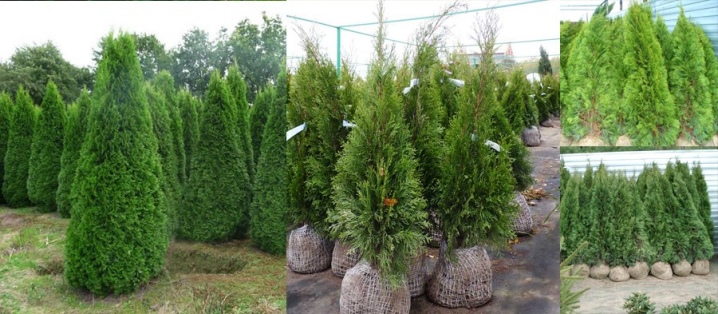
Spring is good because during this period the active development and growth of shoots and roots begins, it will be easier for the seedling to take root, to take root, and it will certainly be able to get stronger after planting and subsequently survive the winter.
For those who are late with the spring planting, there are other deadlines. For example, the summer period, before the onset of extreme heat. But it is very important to observe the temperature regime, and it is strictly forbidden to plant a plant at noon in the scorching sun... Therefore, the best option for summer planting of thuja will be an early cool morning, when the air temperature has not yet reached 18-20 degrees. In addition, when planting a plant in the summer, you need to take care of its safety and organize a cool shady space for it. You can cover it with a cloth or install a special canopy, which for the first time will obscure the immature plant from the burning sunlight.
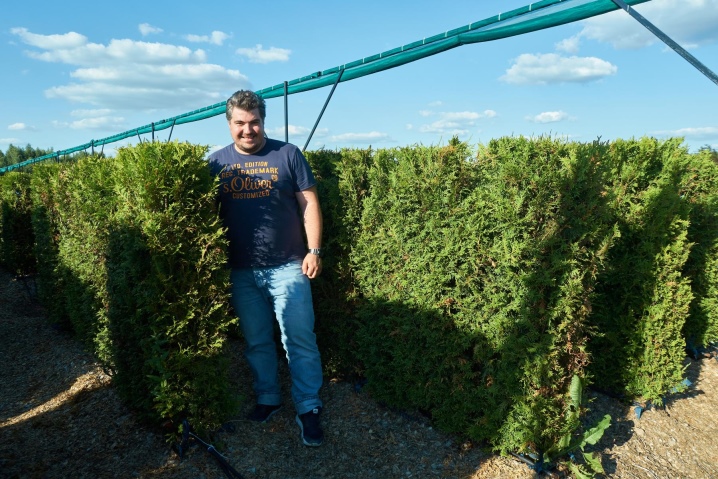
For those who plan to plant thuja in the autumn, there are separate recommendations, since this process requires special attention and has many nuances. For example, it is very important to take into account the fact that the root system of a plant planted in autumn has not yet strengthened its root system, but it has to survive the winter, which will come much earlier than during spring or even summer planting.
First of all, when planting a tree in the fall, you should not postpone it too late, since with the onset of cold weather, a freshly planted thuja can simply die. After planting, you will need to cover the soil near the roots. To do this, you can use dry leaves, straw or just waste from the compost pit - this will help protect the fragile plant from the coming frost. In addition, when heavy rainfall occurs, it is necessary to clean the snow from the tree, since under strong pressure it can break. And, of course, you will need to secure the tree with stretched ropes on four sides, this will help strengthen its condition and create support for the trunk.
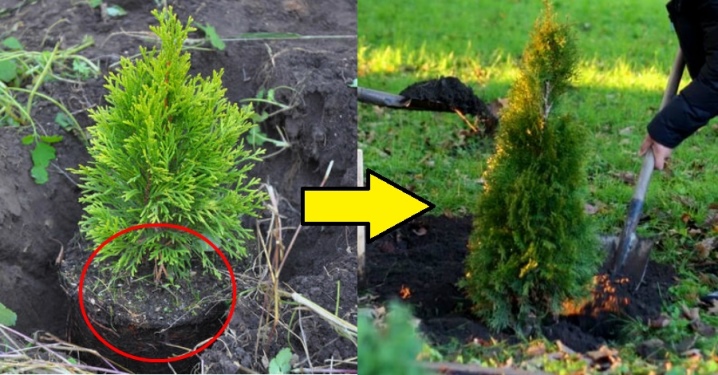
How to plant?
Before you start planting a tree, you need to choose a suitable place, which is also important. The right place is the key to the healthy growth of your tree, because if all conditions are met, you can avoid yellowing of the branches and shedding of needles. It is preferable to plant thuja near the fence, at some distance from it and other trees. But it is necessary to choose a place near the fence in such a way that the tree is always provided with constant sunlight, without which its development and growth will be impossible. It is worth noting the fact that the tree trunk near the fence will not be constantly exposed to the sun, so overheating and burning will also be excluded.
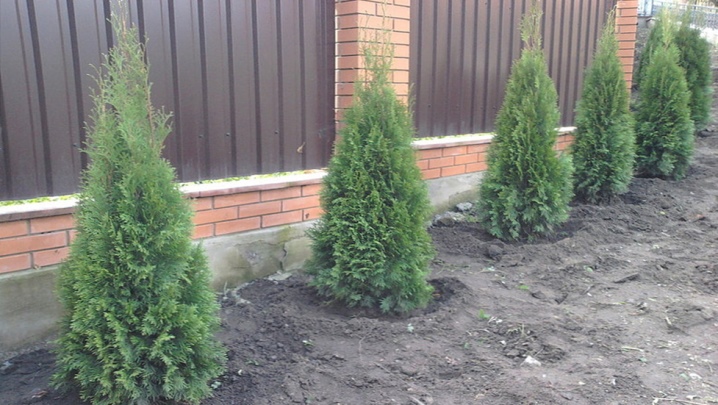
In addition, thuja survives winter winds very hard, so this placement will also help protect the tree from drafts and keep it safe during the cold period.
It is important to choose a place so that the tree is not constantly in the shade, since this will affect its growth and development of the needles - the lack of sufficient sunlight will lead to the fact that the tree will never be lush, and the coniferous branches will begin to crumble and thin out. It is also necessary to exclude places where large trees with a powerful root system are already located., since such a neighborhood will hinder the beneficial development of thuja, as well as places with a close location of groundwater, since stagnant moisture is destructive for this tree.

Having chosen a suitable place, it is necessary to decide on the possible neighborhood of this plant: will it grow alone or you plan to plant a whole hedge of thuja. And if in the first case everything is simple, then in the second one should know several important nuances:
- for planting a hedge, it is necessary to place trees at a distance of 50-70 centimeters from each other;
- so that the hedge is massive and dense, it is better to arrange the trees in a checkerboard pattern in two rows;
- you should not plant a hedge if the space of the site does not allow it.

When the place and landing options are determined, it is necessary to proceed directly to the process. Let's take a closer look at the step-by-step landing technology.
- First of all, it is necessary to organize a planting pit, the depth of which should be up to 1 m, and the diameter up to 80 cm.
- The bottom of the pit must be fertilized by filling with a special soil mixture recommended for growing thuja. You can also prepare the soil yourself by adding turf, humus and peat to its composition.
- Fertilizers can be used for rapid growth.
- A plant in a temporary pot must be watered with a root growth stimulator, and only half an hour after watering can you start planting.
- It is necessary to fill the hole with soil mixture so that the seedling does not go too deep into the ground. The root collar should be located a few centimeters above ground level, since with the subsidence of the soil, the plant itself will take the desired position.
- Then you need to remove the plant from the pot as carefully as possible, without damaging the trunk and roots.
- After that, the seedling should be placed in a hole and half filled up in its space.
- At the next stage, the plant is watered with water in an amount equal to the volume of one bucket. This will have a beneficial effect on soil shrinkage.
- After completely absorbing water, you can fill the hole to the end, while tamping the soil.
- When the hole is completely filled up, you need to make a small hole and water the plant again with the same amount of water.
- Upon completion of all these procedures, the irrigation hole will need to be mulched using peat, compost or shredded wood waste.

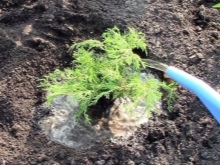

As you can see, the planting process is quite simple, the main thing is to adhere to all these rules. Remember to cover your seedling or provide a shady space to avoid scalding.
Correct care
In the period after planting, the tree will need special care and active support with nutrients, and it is very important to provide it with everything it needs. It is no secret that this tree loves moisture very much, therefore watering will be the main component of thuja care - both during the active growth phase and throughout life. A tree needs 30-40 liters of water every week, depending on the climate and weather conditions. It is necessary to take into account that when watering the soil, subsidence is characteristic, so it will need to be filled up as needed. In addition, irrigation should be carried out from time to time by sprinkling - spraying the tree completely. This will help to saturate the needles, as well as cleanse them of dirt, dust and dried particles.
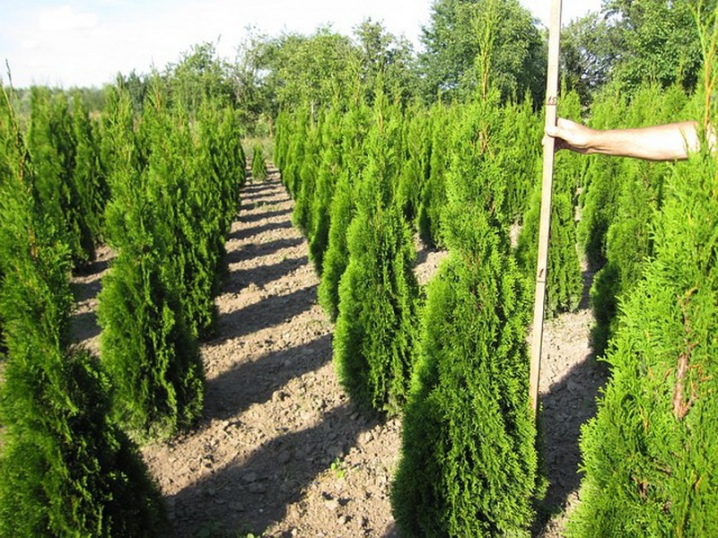
Six months after planting, it will be necessary to introduce the first feeding of the young tree, which will need to be determined based on the planting time.
- If the tree is planted in autumn or early spring, top dressing will need to be done in spring or summer, respectively. For these purposes, ammonium nitrate or simple urea is suitable. You can also use various complex preparations.
- For trees planted in the early summer period, top dressing will be needed in late autumn, but it is better not to delay and do it in September-October, before the onset of severe cold weather. For these purposes, peat, bone meal, wood ash, or the most ordinary compost are perfect.
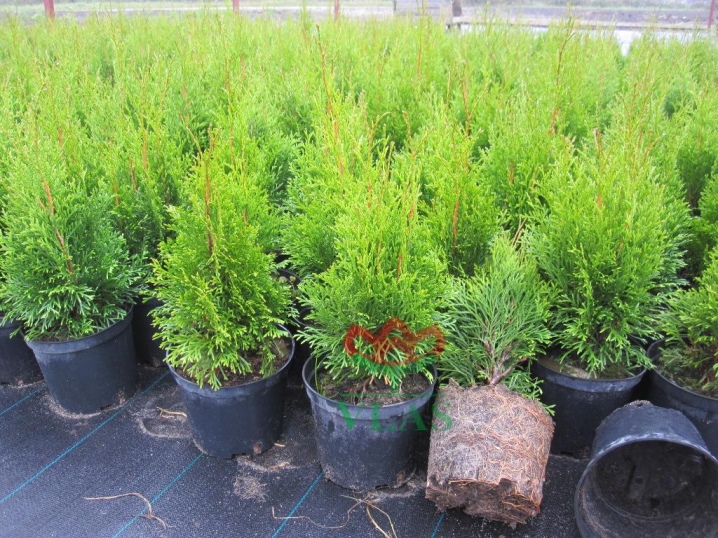
In addition to watering and feeding, the plant also needs a shearing. You need to be especially careful with this process, since careless movements, unnecessarily cut needles and scratches on the trunk can harm the general condition of your thuja. Pruning is classified into two types:
- sanitary, carried out in the spring;
- formative, which should be carried out in the fall.

Sanitary pruning involves removing yellowed needles, frozen shoots and dead branches. If the tree is covered for the winter, you should not prune immediately after you open it. The branches need several days to fluff up and come to their natural state. You can also trim off a living, undamaged crown in order to give the tree a certain shape. It is worth knowing that such a haircut does not harm the thuja, but on the contrary, it saturates the branches with oxygen.
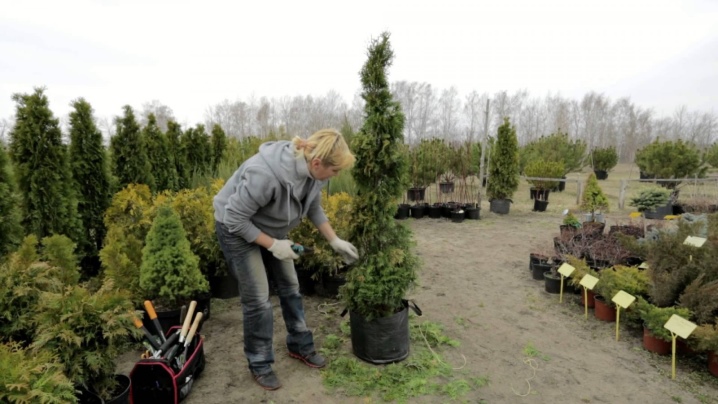
Autumn pruning is done in early September. During this period, preparation for winter takes place, so it is necessary to cut off all long branches that may interfere with a successful wintering. Experts recommend not to divide the haircut into two procedures, but to regularly trim the branches, cutting up to 15 centimeters twice a month.
In addition, a mature tree needs to be regularly fed with various fertilizers, which are usually added to watering. It is best that these are environmentally friendly organic compounds that will not harm either the tree itself, or its root system and soil. All these fairly simple rules of care will help you enjoy the luxurious look of the healthy crown of your tree for many years.
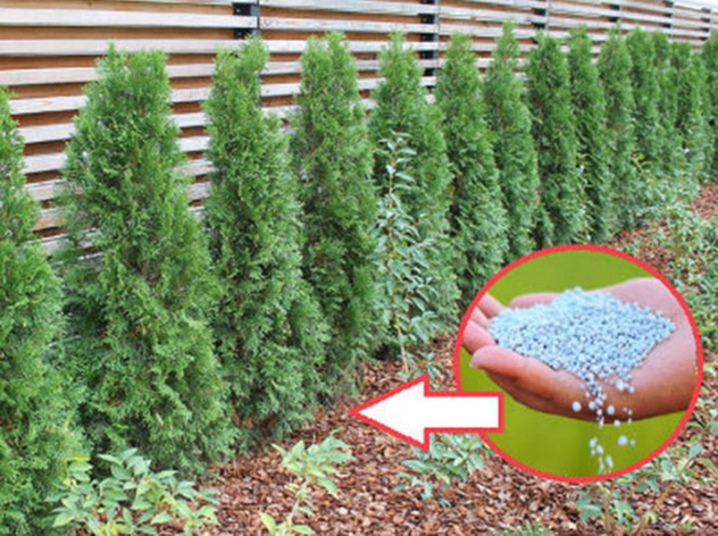
Preparing for winter
To prevent the tree from dying in a particularly cold period, it must be properly prepared for wintering. First of all, you should cover the tree well. It has already been mentioned that thuja is very sensitive to strong winds and drafts, so a reliable shelter will help protect the tree from these factors. It should be noted that adult tall plants are more frost-resistant., therefore, there is no need to cover thuja, the height of which is more than 2-3 meters. This rule applies only to weak, small and young trees.

For shelter, it is better to choose a light-colored material that has wind-resistant qualities. Do not cover the thuja with a woven material that can get wet, freeze and harm the wood. In addition, woven fabrics are very breathable, so the tree will not be protected from winds. The material must be wrapped around the tree, leaving no open spaces, and securely tied with a rope. You will also need to cover the root system. But it is worth noting that for this you need to use exclusively natural materials that will not interfere with the flow of moisture into the soil. In addition, natural materials will subsequently be subject to decay, and will become an excellent fertilizer for wood.
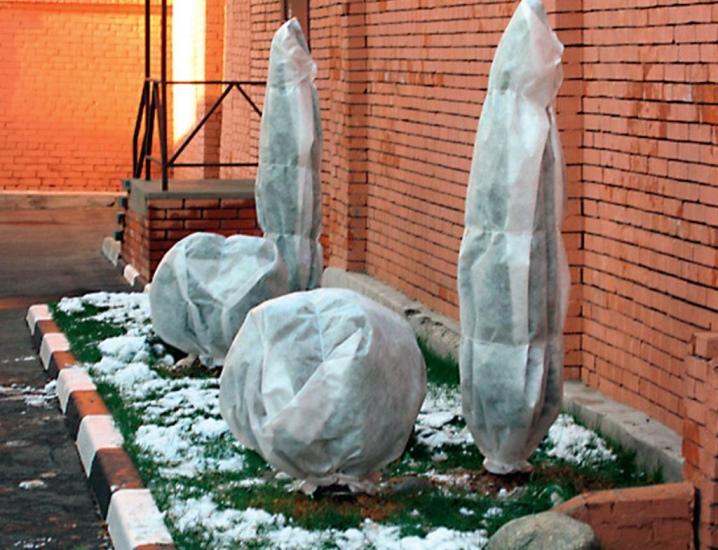
With the onset of spring, when the time comes to open the tree, it is necessary to secure it by installing a shade barrier. It is very important to do this, since the crown of the thuja, after opening, will be most vulnerable to the sun's rays, which can burn it.It is also worth saying that preparation for winter should not be delayed, all these procedures will need to be done by mid-autumn, before the onset of cold weather.
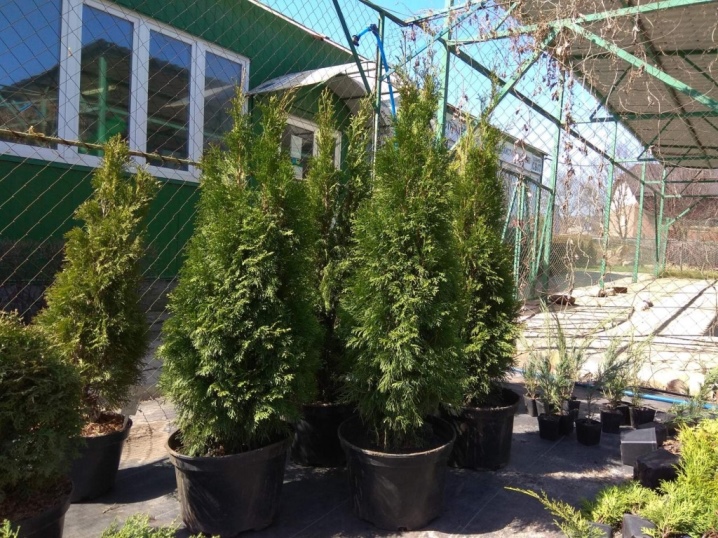
Reproduction methods
When breeding thuja, it is necessary to be very careful, since this process, if done incorrectly, will not only not give results, but also harm an adult tree. The plant can be propagated in several ways:
- cuttings;
- seeds;
- layering.
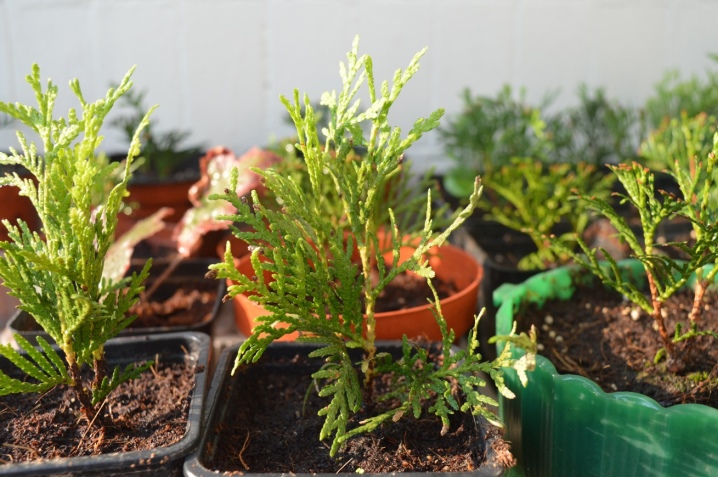
The most popular is cuttings, since this process is considered simpler and more understandable among gardeners. But it is necessary to reproduce in this way exclusively in the spring, so that the adult tree has time to recover, and the cuttings have time to take root.
For reproduction in this way, it is necessary to separate the tops of the near-stem branches of an adult tree, then the thuja will have a characteristic appearance and color. Separating the tops of other branches can cause the tree to have a different shape and a different shade of crown. The stalk should be up to 15 centimeters long, its base should be cleaned and treated from various fungal diseases. After processing, the cuttings are planted in a container with a hole so that the soil is regularly drained, and placed in a bright, warm place.
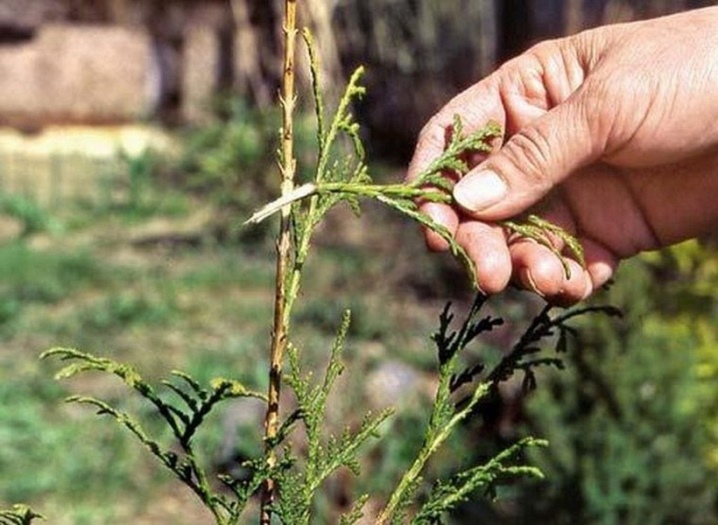
The rooting process of cuttings can last up to 5 months, and during two of them watering of future seedlings must be carried out as a spraying, thereby nourishing the plant completely. When the term is over, the young tree can be transplanted into open ground. Unlike cuttings, when propagating by layering, branch separation occurs only when it has already taken root in the soil. To do this, it must be rejected in advance, sprinkled with soil and sod mixture, and watered regularly, feeding with fertilizers.
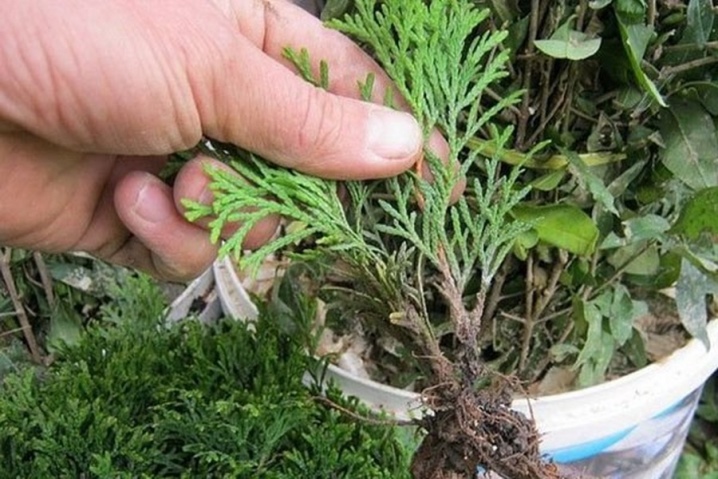
As for propagation by seeds, you should know that seeds on an adult tree ripen closer to autumn, and in order for them to be suitable for growing, it is necessary to collect the cones before they open. Then the cones are dried in a dry place, opened, and seeds are extracted from them. Before sowing, they will need to be soaked for 10-12 hours, then placed in the soil to a depth of 30 centimeters. In places of sowing, the soil will need to be covered so that the seeds are not damaged by various weather conditions.
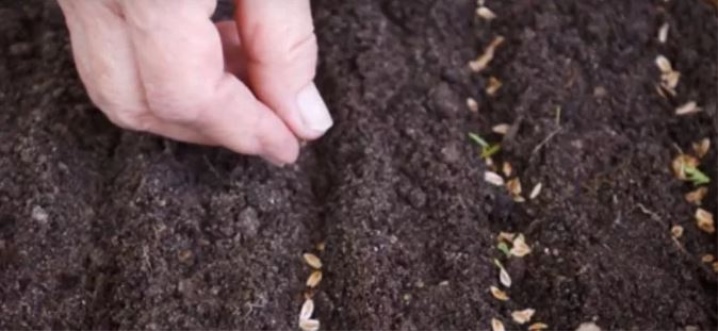
Diseases and pests
Like any other plant, western thuja is susceptible to all sorts of pests, as well as some diseases. Let's consider the most dangerous of them, as well as get acquainted with the methods of struggle. A disease such as late blight is of fungal origin and is considered one of the most dangerous for thuja. The external signs of this disease are as follows:
- the crown withers and takes on a gray tint;
- the trunk of the tree becomes softer at the bottom;
- plaque appears on the branches and trunk;
- the roots begin to break and rot, acquiring a characteristic odor.
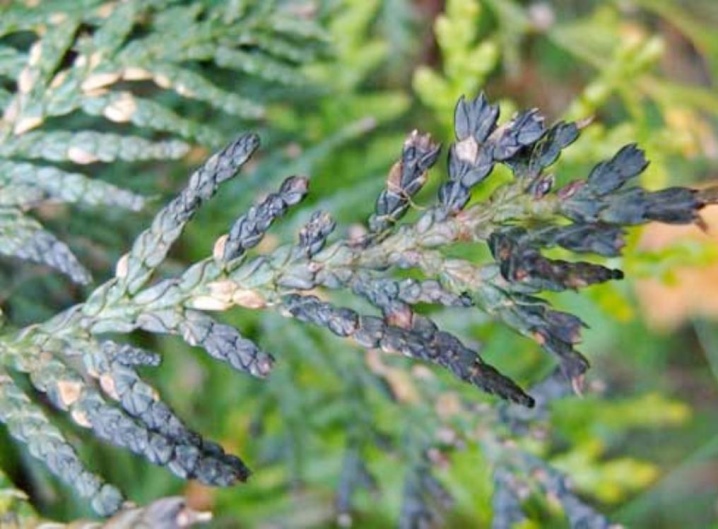
Control methods:
- regular watering with fungicides;
- in the absence of a positive effect, the tree will have to be destroyed by replacing the soil under it, since the fungus can hide and harm other plants that will later be placed in the same soil.

Brown shoots are also classified as fungal diseases. It manifests itself in early spring and has characteristic features:
- yellowed scaly particles appear;
- shoots are affected and then die off.
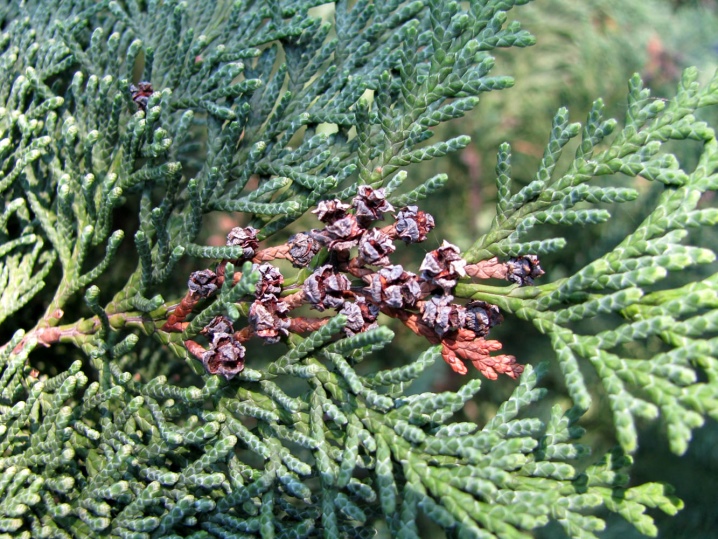
Control methods:
- regular feeding and treatment of the root area with limestone;
- spraying with Fundazol;
- removal of affected shoots in order to prevent the spread of the disease.
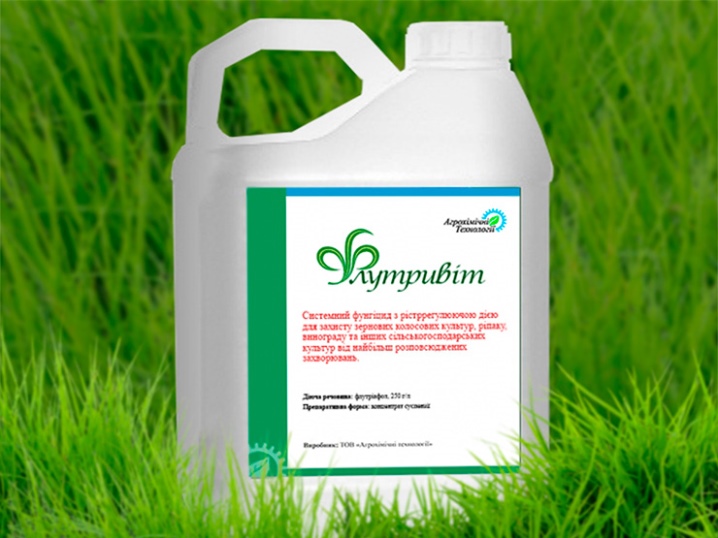
Thuya false shield is another rather dangerous disease, since if untreated it can even lead to the death of a tree. Like any other disease, false shield has characteristic features:
- yellow ulcers on the bark;
- spread of stains.
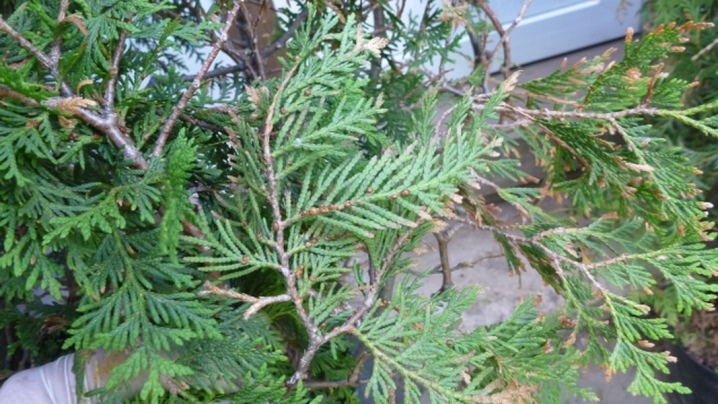
Control methods:
- the use of specialized tools;
- wrapping the trunk with burlap or hay;
- processing branches with alcohol solution or glue from caterpillars.
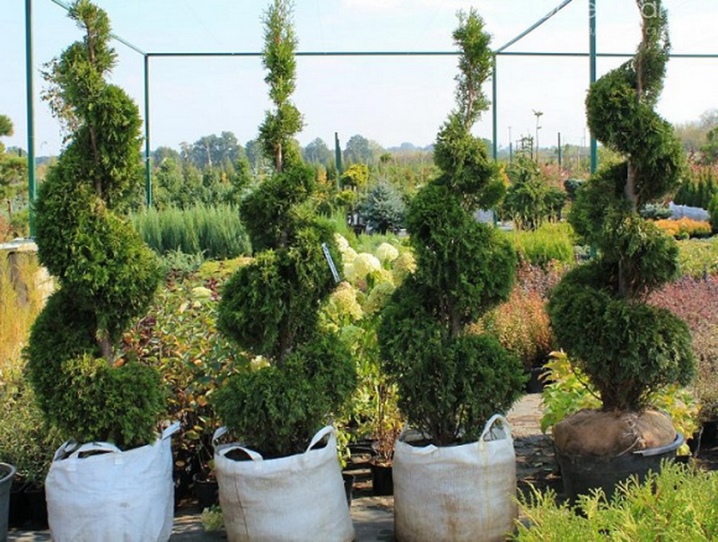
There are also diseases such as schütte and rust, they are fungal in nature and mainly affect young trees. To combat these diseases, special tools are used that can be bought at any gardening store.
Use in landscape design
As mentioned earlier, western thuja is very often used in landscape design, since they are very beautiful, environmentally friendly trees, and also lend themselves well to cutting and forming a crown. Thuja can be planted in any way, depending on what result you want to get.
- It can be a hedge of trees, providing not only coolness and shady space on the site, but also constant air purification.
- It can be a single tree, which is easy to give absolutely any decorative shape. In this case, the tree can be combined with decorative masonry or other small plants.
- It is also possible to plant these trees in small groups, forming some kind of decorative corners.
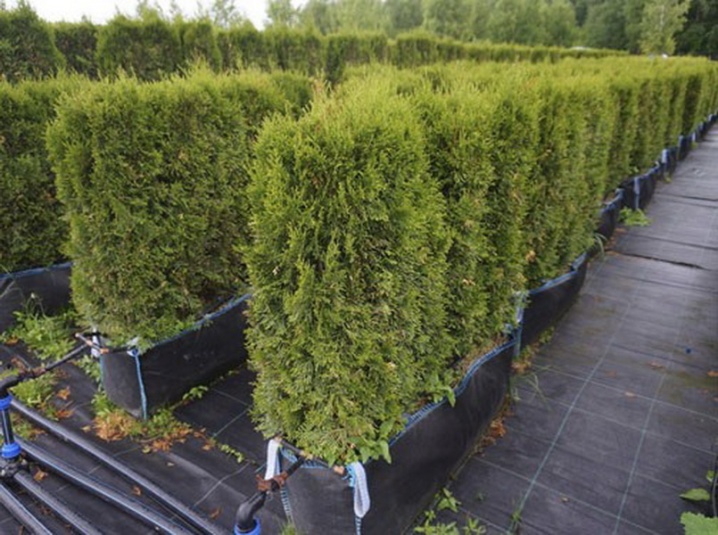
It all depends on your imagination, but it is worth noting that in any case, thuja will decorate your site.
For information on how to properly care for the western thuja "Smaragd", see the next video.



































































The comment was sent successfully.